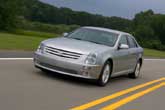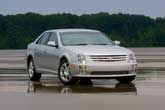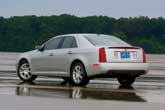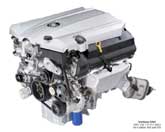Recent Articles
Popular Makes
Body Types
2005 Cadillac STS First Drive
Formidable contender

Milford, Michigan – At this rate, Cadillac is going to get a nasty reputation, an edgy rep, one reserved for the cars that go fastest and make real drivers smile. It started with the CTS, an edgy and sporty luxury sedan, and went as far as the CTS-V – and the SRX – a downright refreshing luxury SUV. Now Cadillac has reinvigorated the most senior member of its lineup -- the Seville – dropping the Seville and keeping the STS, forsaking front wheel drive and adding RWD -- riding on the same Sigma architecture that founds the CTS sedan and SRX sport utility. The new 2005 Cadillac STS also follows the styling trend at GM’s luxury division. Chiseled body lines, jeweled vertical headlights, and “over/under” front bumper driving/fog lights are particularly reminiscent of the newly-introduced CTS. Both the XLR droptop and SRX also share many design cues employed in the STS, although some of the big sedan’s lines have been softened for the luxury market. Clearly, however, STS is another step in redefining the quickly evolving Cadillac brand. Cadillac offers two engines in this full-size 4-door luxury sedan, both sophisticated units equipped with Variable Valve Timing that help deliver smooth, efficient performance. A 24-valve V6 engine displaces 3.6 liters and arrives standard in the base car. Power is an impressive 255 hp. and 255 lb.-ft. of torque. More importantly, however, is the engine’s ability to deliver 90 percent of peak torque from 1,600 to 5,800 rpm.
Page 2: Powerplant
Pricier STS models arrive with a 4.6-liter Northstar V8, producing 320 horses and 315 lb.-ft. of twist. In addition to VVT, both powerplants operate according to electronic throttle control. A 5-speed automatic is the only transmission offered at the present.Both RWD and AWD are available in V8-powered Caddys, while V6 sedans initially make do with rear-drive only. Eventually, however, AWD will become available across the lineup. Under most circumstances this AWD system distributes torque in a 40/60 split favoring the rear. But when traction fades, all four wheels adjust to maximize grip. The AWD hardware works in harmony with StabiliTrak, GM’s electronic stability system that includes traction control. We drove all three models of this upgraded performance sedan recently, following a presentation in GM’s on-site NVH testing facilities, where a vehicle’s quietness is measured in every way imaginable. Whether it was at all by suggestion, or entirely objective, we found the first item of note was the STS’s quietness. Getting into the STS was easy with wide-opening doors, along with seats and a steering wheel that accommodate almost all body sizes and driving positions. After engaging the push-button start, we gave the upscale cabin high marks; however, despite the age of STS buyers having descended, we still feel its look and feel is for “mature buyers”.

Page 3: Engineering
On the other hand, the STS is a showcase of GM’s engineering and electronics, something that appeals to many younger buyers today. For example, the traditional key-in-ignition is history. Instead, drivers carry a fob that tells the vehicle to unlock and disarm as they gain proximity. Once inside, a button on the dash starts the engine, so long as the fob is detected in the car. The same switch turns it off, and when the driver walks away the vehicle locks itself. A clear benefit here is that nothing needs to be removed to gain authorized access, a potential convenience in the winter and safety measure during all seasons (there are special considerations for a failed battery and lost key.). Additionally, a remote starter is offered that operates from up to 200 feet away.We were also greeted by an 8-in. screen that includes a navigation system. One of the largest screens in the industry, it can play DVD movies, with the transmission in park. A Bose Studio Surround stereo system heightened our in-cockpit experience through 15 separate speakers. According to Cadillac, each passenger enjoys 360 degrees of auditory stimulation. Speaking of stimulation, its handling is superb, and in our case, assessed over a road course with a good deal of rough and uneven pavement—during a rain storm, to boot. Steering input is spot on for our tastes, and we found just enough feedback from tires and suspension to keep us zipping along at competent speeds.

Page 4: Every day driving
We tried to unsettle the STS with hard braking and found its stopping rock steady. Likewise, we tried to get the back end of the AWD to breakaway, and were unable to shake it, even on slick pavement, reaching speeds that were slightly over the limit for everyday driving. To compete with the German road cruisers often complemented for their handling, Cadillac has extensively reworked STS’s suspension. The fully independent configuration uses an unequal length control arm and coil-over-shock setup in the front with a multi-link design employing coil springs out back. Anti-roll bars add cornering stiffness at both ends, while Magnetic Ride Control offers lightning fast damper adjustment in either touring or performance mode. Thanks to magnets, the suspension can re-adjust up to one thousand times per second according to road conditions. Cadillac is clearly intent on perfecting its handling - Magnetic Ride Control is derived from GM’s flagship sports car, the new Corvette C6. STS models with the V8 engine are available with Adaptive Cruise Control (ACC), a system that maintains prudent distances behind others via radar. When the system cannot adequately adjust vehicle speed, like during emergency braking, it alerts the driver both audibly and visually through the Head-Up Display. HUD, another option, projects vital information on the windshield for the driver to read. Cadillac reminds customers, however, that ACC does not substitute for the driver’s attention to traffic.

Page 5: Intellibeam
Like ACC, Cadillac’s Intellibeam Headlamps detect other traffic and adjust accordingly. Also available on V8 models, these headlights switch between their high and low beams automatically. When headlights or taillights are perceived the units switch to the low-beam setting. With no oncoming or up-ahead traffic, they stay on high. Cadillac assures that the sensors filter out ambient lighting that would cause unnecessary dimming.While the optional Intellibeam lamps are not crucial components, the technologically advanced safety features are. Eight airbags - two in front, two to the side of the front passengers, and a curtain at each outboard position - maintain occupant integrity in the event of a collision. Four-wheel disc brakes with ABS behind standard 17-in. wheels provide binding power with the Standard or Luxury package checked. Sport treatment yields larger discs surrounded by 18-in. wheels. Rack-and-pinion steering with variable assist is also considered a “Sport” option. Other options include heated and ventilated seats, a heated steering wheel, Tuscany leather, XM satellite radio, a sunroof, and exotic eucalyptus wood trim. The STS could prove a formidable opponent to other mid-size luxury sedans. Five-series and 7-Bimmers, E-class Benzes, and GS/LS430 Lexuses take note - the General now has a contender.

Page 6: FAQs
What is the STS? The new STS, which replaces the Seville STS, is a luxury 4-door performance sedan that has been significantly redesigned and upgraded for 2005.What other luxury rides would STS buyers likely cross shop? Cadillac says it STS buyers would also look at, or cross over from, models such as the BMW 5-and 7-Series, Mercedes E-Class models, Lexus GS/LS 430, Audi A6 and Jaguar S-Type. What are some of the STS’s bells and whistles? STS comes loaded with high-tech (and often connected to both active and passive safety) wizardry-the price of entry in the segment of the market it competes in. It has StabiliTrak, Magnetic Ride Control, Adaptive Cruise Control, Keyless Access with Push Button start, Adaptive Remote Start, Head-Up Display and OnStar.

Page 7: FAQs
What are the engine choices? Cadillac offers two engines. Both are sophisticated units equipped with Variable Valve Timing that help deliver smooth, efficient performance. A 24-valve V6 engine displaces 3.6 liters and arrives standard in the base car. Power is an impressive 255 hp. and 255 lb.-ft. of torque. More importantly, however, is the engine’s ability to deliver 90 percent of peak torque from 1,600 to 5,800 rpm. Pricier STS models arrive with a 4.6-liter Northstar V8, producing 320 horses and 315 lb.-ft. of twist. In addition to VVT, both powerplants operate according to electronic throttle control. A 5-speed automatic is the only transmission offered at the present.Is it RWD only? Both RWD and AWD are available in V8-powered Caddys, while V6 sedans initially make do with rear-drive only. Eventually, however, AWD will become available across the lineup. Under most circumstances this AWD system distributes torque in a 40/60 split favoring the rear. But when traction fades, all four wheels adjust to maximize grip. The AWD hardware works in harmony with StabiliTrak, GM’s electronic stability system that includes traction control.

Page 8: Writer's Notes
Base price: $41,690 - $62,765 (destination charges included) Engine: 3.6-liter V6 (255 hp @6,500 rpm, 255 lb.-ft. @3,200 rpm); 4.6-liter V8 (320 hp @6,400 rpm, 315 lb.-ft. @4,400 rpm) Transmission: 5-speed automatic Wheelbase: 116.4 in. Length: 196.3 in. Width: 72.6 in. Height: 57.6 in. Head/legroom: front: 38.7/42.6 in.; rear: 37.9/38.3 in. Hip/shoulder room: front: 54.6/58.6 in.; rear: 55.6/57.4 in. Curb weight, lbs.: 3,900-4,200 (estimated) Fuel economy: NA Safety equipment: dual front airbags; front side-impact airbags; front and rear curtain airbags; four wheel disc brakes with ABS; StabiliTrak stability and traction control; tire pressure monitoring
